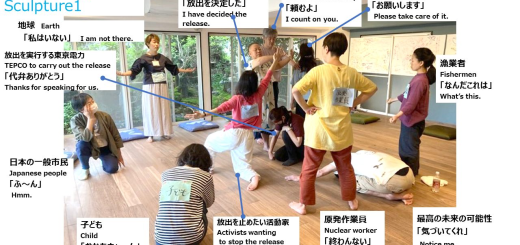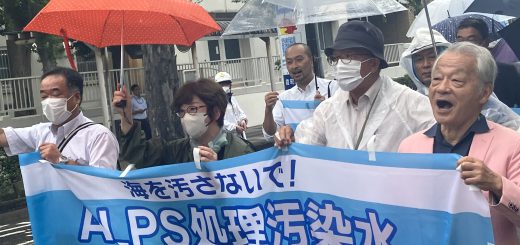Fukushima Daiichi: Contaminated water should not be dumped in the ocean and radioactive debris should not be removed without debate on the end state
By Ban Hideyuki, CNIC Co-Director
Decommissioning work is underway at the Fukushima Daiichi Nuclear Power Station (below, FDNPS), with Fukushima Prefecture requesting that the site be rendered radiation-free vacant land 30 to 40 years after the nuclear accident. On the other hand, while the Mid-and-Long-Term Roadmap is supposedly in accordance with this, how the decommissioning is to be handled after the buildings are demolished remains unclear.
As if casting a stone at these circumstances, the Atomic Energy Society of Japan (AESJ) published a report last year titled “Waste Management from the Point of View of International Standards” (published in July 2020 by their review committee for the nuclear decommissioning of the FDNPS). The report held that in proceeding with decommissioning, establishing the final conditions for the nuclear plant’s former site beforehand (expressed as the “end state”) was important and was intimately related to the resolution of various issues connected with the decommissioning and the future image of Fukushima’s recovery. It was intended to serve as an impetus for deepening discussion among the stakeholders.
In addition, the report estimated the amounts of radioactive wastes to be generated by the FDNPS decommissioning. In this issue, we would like to introduce the contents of the report, including those estimates.
Estimated Amounts of Radioactive Waste Generated by the FDNPS Decommissioning
The report gave its estimates in the form of a table (see Table 1 below), at this point in terms of tonnage. No explanation has been provided on the categories, but what I would like readers to note are the clearance levels estimated for normal nuclear reactors, and the lack of a category for non-radioactive wastes. Filters and adsorption towers from the Advanced Liquid Processing System (ALPS), along with base-isolated buildings, office buildings and other structures, and also trees and other wastes generated, have been exposed to radioactivity and are contaminated by it, so this is to be expected. The severity of contamination is expressed well. What’s at issue in this report is how the ideas behind the categorization of the wastes that are not radioactive wastes specific to the FDNPS have been organized. It is an issue, but relaxation of standards in order to reduce the amount of wastes generated would be inappropriate.
Note that in Japan, spent fuel is considered to have value and is not defined as a “waste,” so fuel debris would pro forma not be included, but it is nonetheless included from the standpoint of realistic thinking.
Four Scenarios of the End State Debate
The basic policy for decommissioning measures will be one of the following three: 1) immediate dismantling, 2) deferred dismantling and 3) long-term preservation.
Immediate dismantling is the policy Japan’s nuclear power plant operators have adopted. They have established a safe storage period of about ten years before dismantling heavily contaminated nuclear reactors, but proceed in the meantime with dismantling of peripheral facilities and equipment. Deferred dismantling is said to be the policy adopted by the UK. Their policy is to preserve the plant for 80 to 100 years and then dismantle it. The sarcophagus method employed at Chernobyl can be considered an example. Long-term preservation is a policy of not dismantling the plant, but waiting for the radioactivity to subside. Long-term preservation has been excluded from consideration in establishing the scenarios. Note that deferred dismantling is expressed as “safe storage” in the scenarios.
Meanwhile, two patterns have been established as assumptions for the “end state”: 1) a state in which the contaminants affecting the equipment and structures and the polluted soil and groundwater have all been eliminated (below, “complete removal”), and 2) a state in which part of the contaminants affecting the equipment and structures and/or some of the polluted soil and groundwater are stored and monitored (below, “partial removal”). The combinations of these produce the four scenarios, as follows.
- Immediate dismantling with complete removal: All of the equipment, buildings, etc. are dismantled and the entire area within the site is restored. All radioactive wastes generated are transported away from the site. The site is freed up for unlimited use.
- Immediate dismantling with partial removal: The above-ground portions of equipment and buildings are dismantled and removed. The site is partially restored. Underground structures are left as they are and continue to be supervised. Part of the contaminated soil, groundwater, etc. is treated and removed. The radioactive wastes generated are kept in an on-site storage area until they can be transported to processing facilities. Note that the radioactive materials remaining continue to be supervised and monitored. The site is freed for use with limitations.
- Safe storage with complete removal: After a defined safe storage period, all of the equipment, buildings, etc. are dismantled and the entire area within the site is restored. All radioactive wastes generated are kept in an on-site storage area as long as needed, then transported away once processing facilities have been secured. The site is freed up for unlimited use.
- Safe storage with partial removal: Dismantling is performed after a defined safe storage period. Details on the dismantling and wastes targeted are as in 2) above. The site is freed for use with limitations.
Scenario Time Bases
In each of the above scenarios, once decontamination and dismantling of the facilities and buildings has been accomplished, the site is to be restored, i.e., the soil, groundwater, etc. are to be treated, and freed up for use. Thus the time base in the case of immediate dismantling is 30 years for decontamination and dismantling (following the Roadmap), with completion of site restoration set at 100 years. In the case of safe storage, the period until completion of decommissioning is 100 years. The period of continued supervision and monitoring of the radioactive wastes is 300 years. The longer the safe storage period, the more the radioactive substances decay, reducing the amount of radioactive wastes needing treatment and disposal.
If Debris Removal Proves Difficult
Retrieval of the fuel debris is postponed for one year from early 2021. TEPCO announced that equipment being made in the UK is not completed yet because of COVID-19. First, a small amount will be retrieved and its properties will be ascertained. During the meltdown, the molten fuel reacted with the concrete below it, and corium as hard as rock is also present. The equipment to retrieve this has yet to be designed and produced, so an investigation to determine what kinds of debris and corium are present is necessary. Such an investigation, however, is impossible. The intense radiation creates various obstacles, such as preventing wireless transmission, damaging integrated circuitry and degrading lenses, making it impossible to view what’s inside. Thus this equipment is still under development. That it would be possible to retrieve the fuel debris within the time frame of the current Roadmap is utterly inconceivable.
Seen this way, the only likely scenarios are necessarily 3) and 4), in which “safe storage” is adopted.
At What Point is Decommissioning Complete?
“Hairo” (reactor dismantling) is the general term used by the public in Japan, but legally, a different expression that translates as “discontinuance measures” is used. These measures differ from the normal in the case of the FDNPS, so the report uses the term “hairo.” In any case, there are four conditions with a total of 121 articles defining completion of “discontinuance measures” under “Regulations on the installation, operation, etc. of nuclear reactors for practical power generation”: 1) completion of the transference of nuclear fuel substances, 2) elimination of radioactivity from the site’s soil and remaining facilities (to or below standard levels), 3) completion of the disposal of radioactive wastes and 4) completion of the handing over of radiation management records.
It will probably be impossible to meet all of these conditions at FDNPS. Particularly condition 3) will be impossible. This is because there will probably be no municipalities willing to receive the radioactive waste. FDNPS is essentially a radioactive waste management facility, and it may wind up continuing to monitor the waste for several hundred years.
What Lessons Can We Learn for the Future?
The report makes the assumption that the contaminated water will be disposed of, but in the case of continued “safe storage,” we are forced to assume that it will be released into the ocean. As fisheries organizations and many municipalities nationwide are opposed to such releases, however, the government is unable to make the decision for oceanic release. Progress in discussions about the “end state” is required prior to oceanic release.



